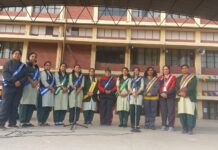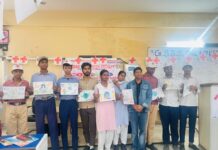A meeting of Task Force constituted under Graded Response Action Plan (GRAP) for Chandigarh, was held today on 11th November 2024, to discuss the urgent measures required to address the poor air quality and increasing levels of air pollution in U.T. Chandigarh.
The meeting was chaired by the Member Secretary, Chandigarh Pollution Control Committee (CPCC). Representatives from departments of Municipal Corporation, Chandigarh (MCC), Traffic Police and Department of Industries were present in the meeting.
Stubble burning was considered as one of the major causeof the increased air pollution in U.T. Chandigarh. Other factors that were given careful consideration and discussion included the approaching winter, the festival season, which increases the number of people on the road in their cars and may result in traffic jams and air pollution, cracker bursting, and temperature inversion.
To improve the air quality of U.T. Chandigarh, which presently ranks in the very poor category with an air quality index (AQI) between 301 and 400, the Task Force decided to take certain measures. MCC to ensure sprinkling/ washing of roads at night time to suppress road side dust mainly arising due to vehicular movements; MCC to ensure that there should be no manual sweeping without sprinkling of water as manual sweeping without sprinkling can cause more suspension of dust in the air; MCC to ensure that mechanical sweeping shall be done with water sprinkling only; MCC to ensure regular use of anti smog guns/water sprinklers for suppression of dust which is collected on trees around road side. The machines will be run for at least 12 hours daily and maintained accordingly; MCC may consider deploying water jetting machines for suppression of road side dust; MCC will ensure that there is no loose soil along road sides and cover through plantation/ greening wherever possible; MCC may consider doubling the parking fee to discourage vehicular traffic; MCC/Engg. Department to ensure that all construction activities have dust mitigation measures in place including green mesh/construction shade nets, repeated sprinkling of water on site and use of anti smog guns etc. In case of non-compliance, the construction activities will be stopped; MCC to ensure that there is no open burning of leaves and other waste in the entire city.
Institutions like Postgraduate Institute of Medical Education and Research (PGI), Punjab Engineering College (PEC), Panjab University (PU) etc. to use anti smog guns/water sprinklers for dust mitigation especially at under construction sites; Traffic Police to monitor traffic intensively and avoid traffic jams outside schools/traffic intersection. May also consider one way traffic during opening & closing of schools. They may ensure strict implementation of Pollution Under Control Certification. Pre – recorded voice messages (like switching of engines at traffic points) may be played at 40 smart city junctions to aware people. Cycle squad team may ensure proper movement of cycles on designated tracks. Manual setting of traffic lights w.r.t. traffic volume during peak hours may be done to mitigate traffic congestion. May ensure challaning on visible emission from buses, three wheelers etc; Transport Department to intensify public transport/promote non-polluting transport like EVs and Pooling of vehicles; Health advisory may be considered by the Health Department; DG sets operation to be strictly banned except in case of emergency/essential services. In case of any unavoidable requirement (other than emergency/essential services), prior permission from CPCC may be obtained. In case of non-compliance, DG set will be sealed. These above conditions will be reviewed/relaxed only after improvement in air quality.
Graded Response Action Plan (GRAP) has been framed for Chandigarh city with an aim to combat air pollution. It is a framework designed to manage air quality and mitigate the effects of pollution at different levels of air quality. It is applicable typically when there is increase in Air Quality Index (AQI) is beyond a limit. The plan outlines specific actions to be taken depending on the severity of the air quality at any given time.
















